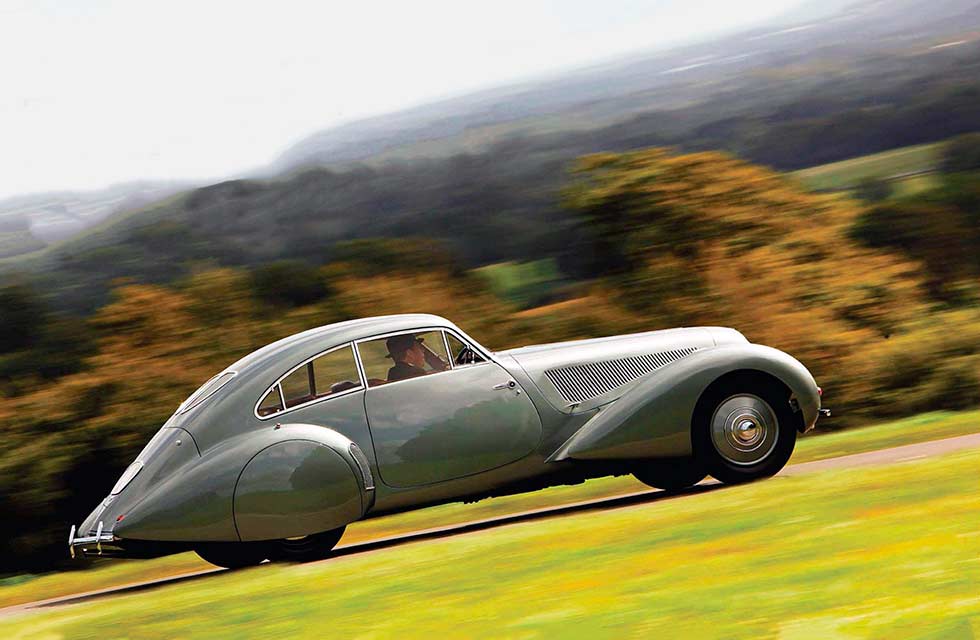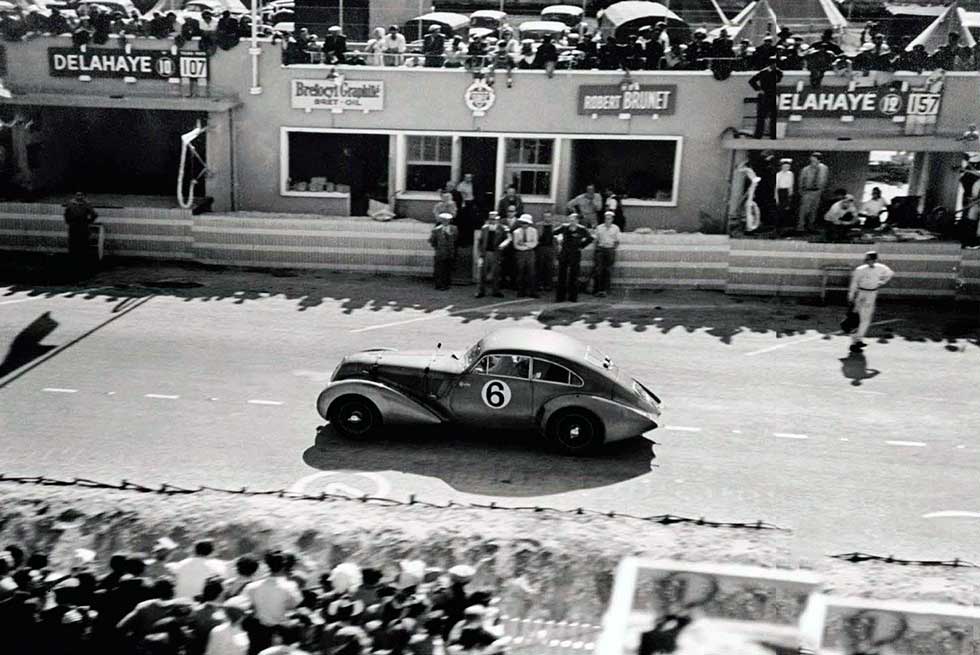
Mick Walsh drives a streamlined four-seater that also raced three times at Le Mans, as the sublime Embiricos Bentley makes a rare return to Europe. Photography Tony Baker.

‘After a family portrait at the finish, Hay packed his luggage and went on holiday’
GENTLEMANLY RACER HEADS TO SARTHE

Best known as the ‘Embiricos Bentley’ after first owner Andre Maris Embiricos, this fabulous Anglo-French 1938 streamlined coupe should really be referred to as the Paulin. Its name should celebrate not the Greek shipping and banking tycoon who financed this famous design’s development and extensive record- breaking, but rather the talented Gallic engineer and aerodynamicist Georges Paulin who created its windcheating profile. There can be no better way to honour this brave pioneer. During WW2, Paulin operated with the ‘Alibi’ Resistance group and, rather than accept a British-planned escape, gave himself up to the Gestapo to protect his undercover team. After his arrest and tribunal, he was shot, aged 40, in Fresnes by a German firing squad.
A dental technician by trade, Paulin loved drawing from an early age and was fascinated by mechanical design. He secured a patent for the retractable roof and also designed hydroplanes, but streamlined bodywork was his passion.
Other than Singer, British manufacturers were late developers when it came to the adoption of streamlined styling. While Bugatti, Delage, Adler and Alfa-Romeo produced slippery closed cars from the mid-’30s, there were only a handful of independent streamlined designs produced across the English Channel. Arguably the most conservative of manufacturers was Bentley and, as glamorous as many of its range of coachbuilt ‘Silent Sports Cars’ were, none could truly be called radical and its traditionalist management insisted that radiators remained a key part of any marque’s identity. In France, Rolls-Royce and Bentley agent Walter Sleator was struggling to compete against the flamboyant creations of Figoni et Falaschi, Letourneur et Marchand and Pourtout, not to mention the brilliant Jean Bugatti’s in-house work. In the age of the new autobahnen and routes nationales, a sleeker design was evolving.
The turning point in the development of the stunning ‘Embiricos’ was a visit to Brooklands in April 1936 by two Bentley engineers who, after witnessing the radical Dubonnet Dolphin on test, returned to Derby to demand funding for experimental aerodynamic work. After much resistance, the project was given over to Sleator: if it was a failure, then Bentley directors could dismiss the idea as French. Embiricos, a wealthy connoisseur of fine cars, agreed to Sleator’s proposal to develop a new style and both agreed that Paulin was the man for the task. At the time of the approach, Paulin was working on a spectacular Delage D8-120, which was nearing completion in Marcel Pourtout’s workshop in readiness for the ’1937 Paris Show. The same team was enlisted for the special Bentley.
Paulin was clearly inspired by the British commission and, once home from his dental business, he started work on the drawings after hours. By November, a scale model was ready for wind-tunnel testing at Mcudon, near Paris, and then at Vickers in the UK. A full-scale wooden buck was completed two months later. The results impressed Bentley and Embiricos, who signed off his deposit for a 4¼-litre chassis, specifying gauges in litres and kilometres. In March ’1938 it was ready to be shipped to Paris, where the build immediately started in carrossier Pourtout’s workshop; four months later it rolled out into the Paris streets to begin testing. The cost to Embiricos was FFr59,210, a huge price that could have bought two coachbuilt bodies.
Such was the secrecy surrounding the prototype that Bentley management and engineers became confused about details, and for many years miscrcditcd designer, builder and owner. Pourtout made two trips to Derby, the first a disaster because he couldn’t speak English and felt unappreciated, but relations later improved.
The primary aim of the streamliner was as a high-speed road car, and as a result the interior was fully trimmed with leather seats and carpets. At 1565kg (3450lb), the car was 159kg (350lb) lighter than a standard 4 ¼ -litre, helped by weight-saving features such as Perspex windows. Bentley engineers F.W Hives and WA Robertson added performance enhancements including higher 8:1 compression and larger SUs, which boosted power from 125 to 140bhp. Uprated shock absorbers, improved brakes and a 2.87:1 ‘overdrive’ top gear were also specified.
‘A PHOTO RECORDED SLEATOR RELAXED AT THE WHEEL WITH THE SPEEDO AT 112MPH’
After taking delivery of his expensive coupe, Embiricos generously agreed to let Sleator take it to Montlhery for some record attempts. The French agent was rated as a superb driver, and confidently set an unofficial one-hour record at 107mph. To promote Bentley’s bold new direction, Sleator set out from Levallois on a road run to Germany to test the car on the autobahn near Mannheim. All went well, and a return trip was planned with the mission to the beat the 80mph average set by Mercedes, but die weather turned forcing him to call a halt at Ulm. Snow and ice hampered the drive to Paris, but a photograph recorded Sleator looking relaxed at the wheel with the speedometer indicating 112mph. After further runs at Montlhery, the Bentley was sent to Britain for experienced record-breaker Capt George Eyston to test at Brooklands. Around the bumpy Weybridge banking it averaged 114mph in the hour. Sleator secured for Bentley two places at the 1939 Le Mans, but management had a change of heart and cancelled.
After a little over a year, Embiricos decided to sell the one-off coupe. The businessman seems to have barely driven the car and may have become frustrated by the lengthy loans for testing and record attempts. On 22 July 1939 it was sold to HSF ‘Soltan’ Hay but, with the outbreak of war, the Bentley was put into storage. There are, however, a few historic photos of the car fitted with blacked-out headlights: perhaps the temptation to use it proved irresistible.
When the Le Mans 24 Hours was revived in 1949, Hay entered the Bentley with journalist/racer Tommy Wisdom enlisted as his co-driver. The trend for streamliner coupes had developed since Louis Gerard’s Delage and the sleek Adlers ran in 1937, so the Pourtout bodywork was specially modified for the 11 -year-old Bentley’s competition debut. Leather bonnet straps were an event requirement, while twin fuel-fillers sprouted from the split rear window and a triple vent to cool the back brakes was cut into the rear wing. How much of the interior was removed isn’t recorded, but alongside the likes of the exposed Delahaye rivals and stripped-out Aston-Martin DB2 team cars the Embiricos must have been the most refined car that ever raced at Le Mans. Hay and Wisdom maintained a strict average, purring on through die evening and night. The drama of losing top gear in the final hours put added strain on the smooth 4.2-litre straight-six, yet at 4pm on Sunday it finished a highly impressive sixth, ahead of all of the new Astons.
Encouraged by its debut, Hay entered the Bentley again in 1950 but this time with wealthy amateur Hugh Hunter alongside. As always, the car was driven to the event and the privateer team checked in at the Hotel Moderne, where the pre-war ‘Bentley Boys’ had lodged. Wearing number 12, the still modem-looking design kept its bumpers on and featured a revised exhaust with triple pipes. A second Derby Bentley was entered, Eddie Hall’s TT roadster fitted with an awkward-looking hard-top, which finished eighth, six places ahead of the Embiricos.
Amazingly, Hay was back for a third attempt in 1951 with another different co-driver, Tom Clarke. Story has it that the Embiricos arrived at the circuit laden with luggage and children, because Hay planned to continue for a family holiday after the race. The big Bentley plugged away, keeping clear of the super-fast new Jaguar C-types, but it was third time unlucky as dynamo failure slowed progress. The team motored on with failing lights, but the engine refused to restart at the final pitstop. Following a lengthy delay the team managed to coax it into life, but after crossing the line Hay was informed that he’d failed to complete the minimum distance by just four miles. Although it was not officially classified, the distance of 2765km (1728 miles) would have placed the Bentley 22nd, but it still claimed a record for three consecutive Le Mans finishes. The great marque wouldn’t return to Le Mans until the Speed 8’s debut in 2001.
After taking a family portrait at the finish, I lay repacked the car and, with dynamo repaired, headed off on vacation. En route home via Paris, he decided to call in at Montlhery for one last endurance run. Without a wash or a change of tyres, the sleek grey coupe flashed around the hallowed banking to record 106 miles in the hour, just a mile off Sleator’s best in 1939.
Hay was clearly attached to the Embiricos and kept it until 1969, when it was sold by Sotheby’s for £4000, a hefty figure for the time. Sixteen years later, die value had risen to £120,000 when auctioned by Coys. At some point it had been repainted an RAF-style blue, but a restoration was carried out when it was bought by a Californian collector. Now a stunning metal lie slate, the Embiricos is a regular concours-winner, including Best of Show at Meadow Brook in 2001.
Following a 27-year absence, this magnificent Bentley returned to Europe to mark the 110th anniversary of Paulin’s birth, appearing at the Circuit de la Sarthe for the Le Mans Classic where it lapped alongside the Cunningham Cadillacs – coupe and ‘Le Monstre’- just as they raced in 1950. Other prestigious outings included the Windsor Concours and the Goodwood Revival, where it won the public vote for Most Beautiful Car in the Earls Court Motor Show. Now back in a private museum in northern California, it keeps company with several seminal pre-war streamlined coupes including the Mercedes-Benz 500K Autobahn-Kurier.
THE 13-YEAR-OLD CAR FLASHED AROUND THE BANKINGTO RECORD 106 MILES IN THE HOUR’
The styling of the Embiricos looks neither English nor French to me, more in the mould of Milan-based cairozzerid Touring’s aerodynamic bodywork. Without the Bentley badges on the streamlined cowl and bootlid it would be quite a challenge to identify, which explains the Derby management’s hesitation about die aerodynamic beauty. Yet I’d certainly argue its case as the finest-looking pre-war British coupe. With nothing more than functional louvres, grille, Marchal lights and flush doorhandles, the Embiricos has a proud purity that contrasts with flashier ’30s French designs. My favourite aspect is the beautifully contoured wings that, along with the tapered rears, evoke the aircraft of the era. Only the high, forward grille design detracts and the taut fastback tail is breathtaking.
Open the deep, long, rear-hinged door and even the Perspex windows don’t mark this out as a lightweight GT. Getting in rapidly for a Le Mans start must have been tricky because the right-hand gearlever and handbrake obstruct. The metal dash is painted to match the body and packed with switches, lights and dials, dominated by standard black-faced rev counter, redlined here at 4500rpm, and 130mph speedo. Tan leather and cream carpets complement the car’s elegant, understated style, while the broad three-spoke wheel is almost buried in your lap.
The Derby gearbox has a delicious slicing action, with plenty of mechanical feel. The ratios are wide, so a double-declutch into second is advised but, once out onto the rolling roads of the South Downs, the Embiricos soon reveals its long-legged refinement. The steering lightens at speed but is sharp and responsive enough to confidently press on. The ride, as you’d expect from a Bentley, is impressive and there’s little wind noise; you can’t help thinking that I lay and his co-drivers must have been the most relaxed competitors at Le Mans. The brakes arc strong and the handling on the tall, narrow tyres feels well-balanced as far as I dare push this unique beauty. The 4257cc ohv ‘six’ lacks top-end punch, majoring on smooth, torquey grunt.
Sitting at the wheel today and looking down that long bonnet, its difficult to imagine that this gorgeous car, now in concours condition, has such a colourful history, and such a high mileage – by 1939 it had already clocked up 120,000. Graves or monuments rarely do justice to the heroes they honour, but there’s no more fitting tribute to Georges Paulin’s talent than this beautiful coupe. Seeing it back at Le Mans in 2012 was a special moment.
Deep doors and strongly tapering wings emphasise aviation influence. The slim bumpers stayed on car for Le Mans in 1950. The sleek styling of the Embiricos was developed using wooden models made by Paulin and tested in the wind tunnels at Meudon and Vickers. Clockwise, from main: aggressive nose, with big Marchal lights; cockpit his traditional English feel: tuned engine with higher compression and bigger – SU carbs; streamlined catches and flush handles.










